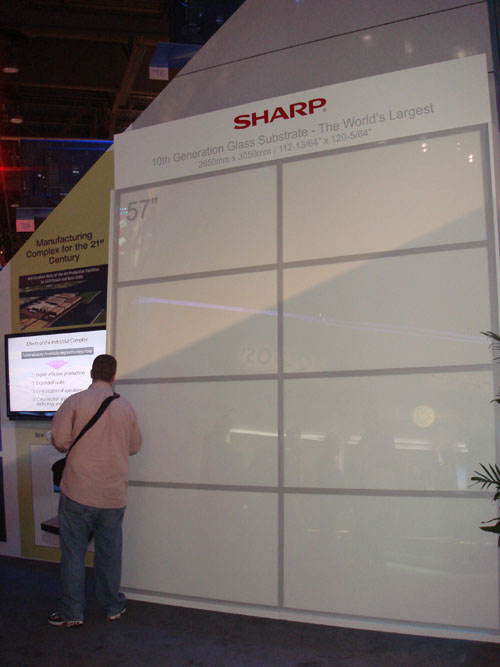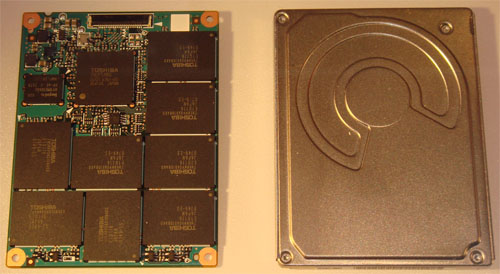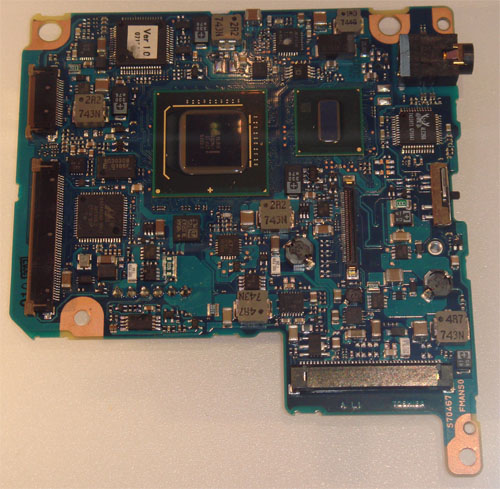I saw a couple of things at CES this year that I actually thought were worthy of sharing. Usually it’s just faster, shinier, bigger, badder gadget after gadget — yawn. I’m pretty jaded, you could say, when it comes to gadgets. I still carry around and cherish my aging Blackberry, and despite the nasty inch-long crack in the front bezel everything works great. It’s almost a badge of honor–no iPhone could handle that kind of real-world abuse and keep on serving its owner so faithfully.
The most stunning thing I saw at CES this year was no gadget, however. It was a mock-up of the “motherglass” substrate that Sharp uses to make its 57″ LCD panels.

That is indeed the mother of all glass substrates.
There’s these huge frickin machines somewhere out there in this world that takes in that 9 foot piece of glass and deposits thin films of silicon on it, and images microscopic patterns into the films to make all those big, beautiful hi def LCD displays that the gadget freaks lust after. I lust after the machine that makes those panels–eight 57″ LCDs panels at a time. It makes those 12″ wafers at the Intel booth look well…small.
Other noteworthy things were the 128 gigabyte 2.5″ solid state flash drive for laptops that Toshiba had on display at their booth. I think there was another vendor that offered drives like this–Sasmung I think? But they didn’t have the circuit boards out for me to gawk at like Toshiba did.
Click on the image for a larger version of the circuit board. The drives are currently priced at $10/gigabyte, but hey, you know, Moore’s law will fix that eventually (although eventually is getting pushed out farther and farther as Moore’s law slows down). These drives are much faster than a standard hard drive for random seek, so it makes things like rebooting your laptop happen in half the time. Personally, I’d love to see this technology combined with a couple gigabytes of embedded DRAM and a smart caching chip to make one wicked fast mass storage device.
The other thing I saw that was neat is a Menlow-based motherboard, the first I had seen. I uhh…forgot what product it was in, it’s some Toshiba ultra mobile PC, but who cares about that; I’m sure engadget has some article on it if you’re into those kinds of things. The motherboard was the interesting part for me.
Click on the image for a larger version of the motherboard.
That’s it for now — I only got through about a third of the exhibits there so far, I had a lot of meetings for the past couple of days. If I find anything else really interesting tomorrow I’ll post it!


I didn’t even realize you were going to be here.
Actually, I don’t think solid state will speed up the boot time on a mac all that much, at least boot until login screen.
Apple developed a trace-based caching scheme, so during the boot to login prompt, the disk is doing effectively linear access, where the flash architecture isn’t a benefit.
Microsoft could copy it should they care.
Also, on a notebook, supsend/resume from hibernation is also linear write/read. How often do you reboot your laptop, vs wake from hibernation/sleep?
I’d more be interested simply because no moving parts -> greatly increased reliability, and DB/server workloads which require large data set, random access.
Finally, $10/GB is not that bad already. There are probably some interesting server uses for it already (6x in a 1u DB server would be very nice).
Likewise, the linux people could copy it should they care.
In response to the above, yes – one of the primary consumers of SSDs right now are large/fast database installations.
The machine that handles that glass sheet produces 8 “57 inch” screens from one plate. I’m guessing that once the yield is high enough, with a little tweaking it can produce 2 “113 inch” screens from one plate. Keeping the same 1:1.87 aspect ratio, with a little wasted area, it can make 6 “60 inch” screens or a single whoppping “120 inch” screen from the same plate. This means that if I were rich enough, I could sit in front of a HDTV that is ten feet wide and five feet high.
And no doubt the retooling is all in software.
-Wang-Lo.
[…] Mother of all glass substrates – Link. […]
Another way to reduce boot times would be like oh I don’t know reduce bloat? All the modern operating systems are absurdly fat. Does anyone remember how fast BeOS booted into the Tracker — on a PowerPC 603 using a 5400 RPM SCSI 2 disk?
So few programmers know how computers work, though, that to train them would cost far more than $10/GiB saved…
[…] Source and image courtesy: Bunnies Blog […]
China, the glass panels are made in China. Drawings for one of the factories I saw showed a building that could house 11 747s.
[…] Flash 5GBP […]